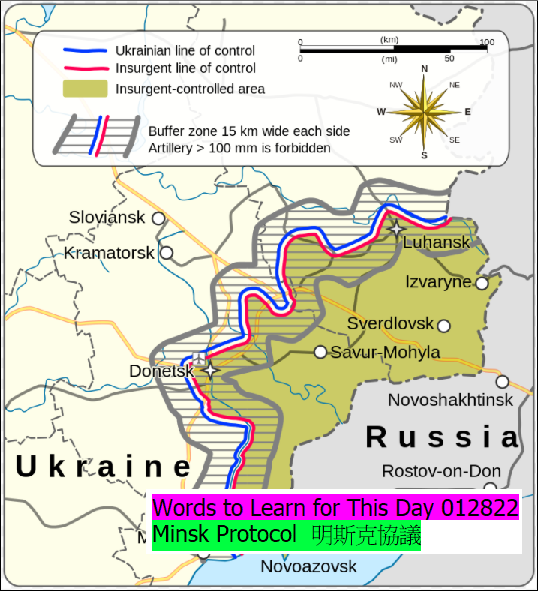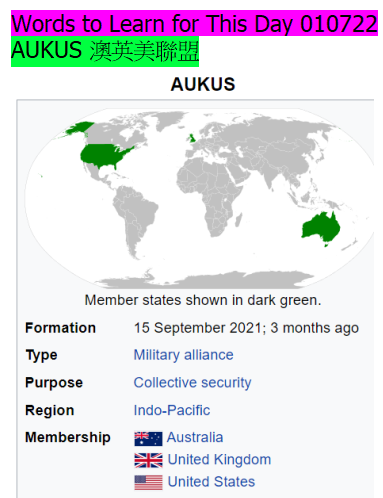The Minsk Protocol is an agreement which sought to end war in the Donbas region of Ukraine. It was written in 2014 by the Trilateral Contact Group on Ukraine, consisting of Ukraine, the Russian Federation, and the Organization for Security and Co-operation in Europe (OSCE),[1][2][3] with mediation by the leaders of France and Germany in the so-called Normandy Format.
After extensive talks in Minsk, Belarus, the agreement was signed by representatives of the Trilateral Contact Group and, without recognition of any status, by the then heads of the Donetsk People's Republic and Luhansk People's Republic.
The agreement, which followed multiple previous attempts to stop the fighting in the Donbas, aimed to implement an immediate ceasefire. It failed to stop fighting in Donbas,[4] and was thus followed with a new package of measures, called Minsk II, which was signed on 12 February 2015.[5] This too failed to stop the fighting, but the Normandy Format parties agreed that it remains the basis for any future resolution to the conflict.
Reactions
The new package, commonly referred to as "Minsk II", was criticised for being "highly complicated" and "extremely fragile", and for being very similar to the failed Minsk Protocol.[5][34][35] The New York Times reported that the plan had "included some tripwires", such as not demarcating control over the city of Debaltseve, which was the site of the most fierce fighting at the time of the plan's drafting.[5][36] Following the Minsk talks, Chancellor Merkel, President Hollande, and President Poroshenko attended a European Union (EU) summit in Brussels.[37] At the summit, the Minsk participants briefed EU leaders about the talks. During the briefing, they said that President Putin had tried to delay the implementation of a ceasefire by ten days, so as to force Ukrainian troops in Debaltseve to surrender their positions. For his part, President Putin said that the Debaltseve defenders were encircled, and that the separatists expected them "to lay down their arms and cease resistance".[37] Kommersant reporter Andrey Kolesnikov wrote that implementation of the ceasefire in Debaltseve hinged upon whether or not Ukrainian forces were truly encircled, "Above all, does it exist or not? Vladimir Putin insisted that it [the encirclement] exists and that if a cease-fire agreement is reached, it will be odd if it isn't violated: Those in the kettle will certainly try to get out of there; those who have boiled that kettle will try to collect the foam".[38] quoted from Wikipedia
After extensive talks in Minsk, Belarus, the agreement was signed by representatives of the Trilateral Contact Group and, without recognition of any status, by the then heads of the Donetsk People's Republic and Luhansk People's Republic.
The agreement, which followed multiple previous attempts to stop the fighting in the Donbas, aimed to implement an immediate ceasefire. It failed to stop fighting in Donbas,[4] and was thus followed with a new package of measures, called Minsk II, which was signed on 12 February 2015.[5] This too failed to stop the fighting, but the Normandy Format parties agreed that it remains the basis for any future resolution to the conflict.
Reactions
The new package, commonly referred to as "Minsk II", was criticised for being "highly complicated" and "extremely fragile", and for being very similar to the failed Minsk Protocol.[5][34][35] The New York Times reported that the plan had "included some tripwires", such as not demarcating control over the city of Debaltseve, which was the site of the most fierce fighting at the time of the plan's drafting.[5][36] Following the Minsk talks, Chancellor Merkel, President Hollande, and President Poroshenko attended a European Union (EU) summit in Brussels.[37] At the summit, the Minsk participants briefed EU leaders about the talks. During the briefing, they said that President Putin had tried to delay the implementation of a ceasefire by ten days, so as to force Ukrainian troops in Debaltseve to surrender their positions. For his part, President Putin said that the Debaltseve defenders were encircled, and that the separatists expected them "to lay down their arms and cease resistance".[37] Kommersant reporter Andrey Kolesnikov wrote that implementation of the ceasefire in Debaltseve hinged upon whether or not Ukrainian forces were truly encircled, "Above all, does it exist or not? Vladimir Putin insisted that it [the encirclement] exists and that if a cease-fire agreement is reached, it will be odd if it isn't violated: Those in the kettle will certainly try to get out of there; those who have boiled that kettle will try to collect the foam".[38] quoted from Wikipedia
乌边境全线备战 美增兵“预备调遣” 乌东进入战争前夜?20220126 |《今日关注》CCTV中文国际
Jan 27, 2022
Jan 27, 2022
China backs Putin as top diplomat warns US that Russia's security demands 'must be taken seriously' amid fears of war in Ukraine
Jan. 27 - China has thrown its back behind Russia over Ukraine, warning the US that Putin's security demands must be 'taken seriously'.
Foreign minister Wang Yi told Secretary of State Antony Blinken that he should abandon his 'Cold War mentality' and engage in negotiations during a call today.
'All parties should abandon the Cold War mentality and form a balanced, effective and sustainable European security mechanism through negotiation,' Wang said.
'Russia's reasonable security concerns should be taken seriously and resolved.'
In a nod to Moscow's concerns about the expansion of the NATO alliance in Europe Wang added that 'regional security cannot be guaranteed by strengthening or even expanding military blocs'.
The exact contents of Blinken's letter to Putin are not being made public, but Blinken said it contains 'serious' offers to de-escalate tensions.
These are said to include controls on nuclear arms and limits on military exercises, according to the New York Times.
After speaking with Blinken, Wang added that 'regional security cannot be guaranteed by strengthening or even expanding military blocs'.
Wang also urged the US to 'stop interfering' in the Winter Olympics, which are set to take place next month in Beijing. more from MailOnline
US lawmakers praise Taiwan at Lai meeting
Feb. 28 - A bipartisan group of US lawmakers has praised Taiwan for its determination to uphold democracy, Vice President William Lai (賴清德) said on Tuesday during a stopover in Los Angeles en route to Honduran president-elect Xiomara Castro’s inauguration.
Several lawmakers at an online meeting with 17 members of the US Congress earlier that day praised Taiwan for sticking to democracy, Lai told the Taiwanese community in Los Angeles via a videoconference.
They hailed the nation for not bowing to pressure from China, despite Beijing sending warplanes into Taiwan’s air defense identification zone and conducting disinformation campaigns, Lai said. more form Taipei Times
Upstream Operations
...The fact that Taiwan’s onshore oil and gas reserves could be depleted within 10 years from now drives CPC’s continued engagement in overseas exploration and production as well as M&A activities. CPC has also reset its overseas exploration strategy in line with both the government’s New Southbound Policy and with trends in the international energy industry – which means being active in joint-ventures and/or acquisitions pertaining to oil and natural gas producing assets in places such as Southeast Asia and the United States and then developing them for commercial production. Exploration for conventional oil and gas is currently focused on America (including California, Paraguay and the Gulf of Mexico), Southeast Asia, Australia and offshore West Africa; for unconventional resources, the focus is on acquiring shale oil and gas assets in the United States, building up relevant technical capabilities and gradually increasing cooperation on unconventional resources with other countries. In all of the aforementioned activities, CPC is working vigorously to deploy its available resources to best advantage, on core overseas target areas that hold out the possibility of discovering oil and gas resources with commercial production value and that will materially raise the degree of self-sufficiency.... quoted from CPC Corporation, Taiwan
...The fact that Taiwan’s onshore oil and gas reserves could be depleted within 10 years from now drives CPC’s continued engagement in overseas exploration and production as well as M&A activities. CPC has also reset its overseas exploration strategy in line with both the government’s New Southbound Policy and with trends in the international energy industry – which means being active in joint-ventures and/or acquisitions pertaining to oil and natural gas producing assets in places such as Southeast Asia and the United States and then developing them for commercial production. Exploration for conventional oil and gas is currently focused on America (including California, Paraguay and the Gulf of Mexico), Southeast Asia, Australia and offshore West Africa; for unconventional resources, the focus is on acquiring shale oil and gas assets in the United States, building up relevant technical capabilities and gradually increasing cooperation on unconventional resources with other countries. In all of the aforementioned activities, CPC is working vigorously to deploy its available resources to best advantage, on core overseas target areas that hold out the possibility of discovering oil and gas resources with commercial production value and that will materially raise the degree of self-sufficiency.... quoted from CPC Corporation, Taiwan
Live: World's largest semi-submersible oil and gas production platform sets off for South China Sea
Streamed live on Jan 17, 2021
China's self-built semi-submersible oil and gas production platform is ready to leave its construction site in east China's Shandong Province and head to the Lingshui 17-2 gas field in the South China Sea – the biggest gas field in China. The platform is the world's first semi-submersible oil and gas production platform and weighs over 100,000 tonnes. Join CGTN's reporter Cao Bing for more.
Streamed live on Jan 17, 2021
China's self-built semi-submersible oil and gas production platform is ready to leave its construction site in east China's Shandong Province and head to the Lingshui 17-2 gas field in the South China Sea – the biggest gas field in China. The platform is the world's first semi-submersible oil and gas production platform and weighs over 100,000 tonnes. Join CGTN's reporter Cao Bing for more.
CPC drilled 3 wells in Taichung to help relieve drought
Apr 19, 2021
With no relief in sight for the ongoing drought, the nation''s oil refiner CPC Corporation has stepped in to drill for water in Taichung. CPC brought out its heavy-duty drilling rig to a spot near Liyutan water purification plant. According to CPC''s drilling engineering team, the principle for drilling a water well is similar to that for drilling an oil well. In Taiwan, oil wells have to be drilled to a depth of 2,000 to 3,000 meters. Water wells, on the other hand, require a depth of just 350 meters, which can be easily reached by CPC''s drilling rig. The three wells that were drilled are expected to produce 15,000 tons of water a day, providing a new water source for more than 60,000 people.
Apr 19, 2021
With no relief in sight for the ongoing drought, the nation''s oil refiner CPC Corporation has stepped in to drill for water in Taichung. CPC brought out its heavy-duty drilling rig to a spot near Liyutan water purification plant. According to CPC''s drilling engineering team, the principle for drilling a water well is similar to that for drilling an oil well. In Taiwan, oil wells have to be drilled to a depth of 2,000 to 3,000 meters. Water wells, on the other hand, require a depth of just 350 meters, which can be easily reached by CPC''s drilling rig. The three wells that were drilled are expected to produce 15,000 tons of water a day, providing a new water source for more than 60,000 people.










